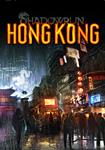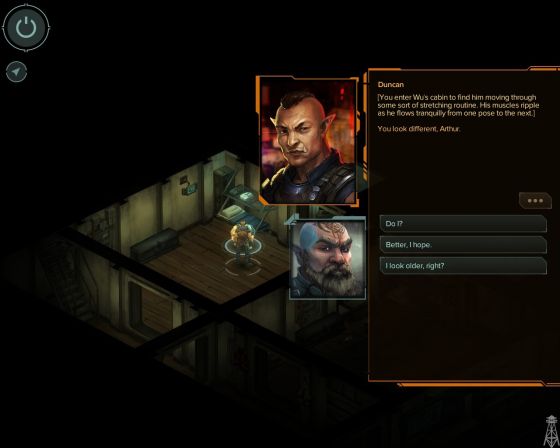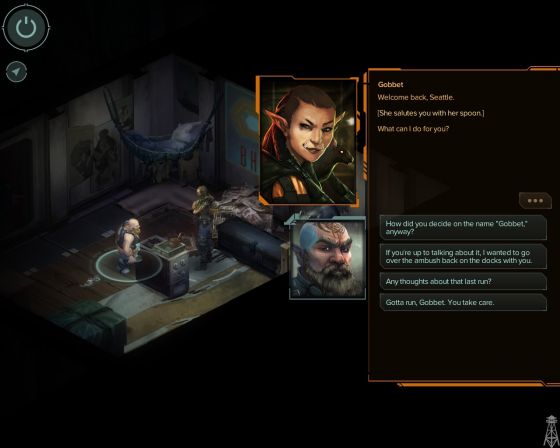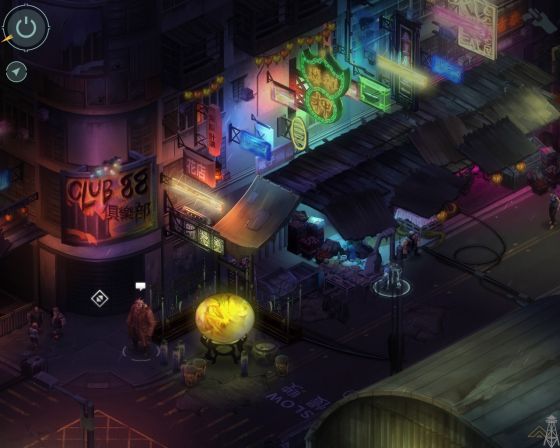Shadowrun: Hong Kong Review
Things aren't really so different under the neon lights of Hong Kong than in the cold rainy streets of Seattle or Berlin. Corporate greed runs the world and you're the unlucky pawn caught up in something way over your head. Shadowrun: Hong Kong shares a lot of features with its two predecessors. In many ways it's a conservative game. There are some tweaks here and there. The matrix has been redone, but it still has a relatively periphery position in the game as a whole. The way cyberware is installed has been expanded. There is a new tileset, which is beautifully done. None of these things change the fact that anyone who has played either of the earlier Shadowrun games will feel right at home with Shadowrun: Hong Kong.
Story and Characters
Anyone who has played any of Harebrained Schemes' Shadowrun games knows that the story and writing are the strengths of the franchise. Shadowrun: Dragonfall added companions which made Dragonfall not only much more interactive, but also much more entertaining than Shadowrun Returns. Shadowrun: Hong Kong improves upon this once more.
Excellent writing is one of the strengths of Shadowrun: Hong Kong.
You start as a poor adventurer called in on a favor. By trying to do the right thing the situation grows over your head. You are bailed out by a crime boss, who expects your services in return. Luckily for you, your enemies are her enemies and she gives you a safe haven and the chance to get revenge, redemption, or power, depending on what it is exactly you want. Her den of corruption becomes your home base, and a motley assortment of characters become your team. There are five companions in the game, three of whom you get more or less at the outset. Unlike in Shadowrun: Dragonfall, I found all of these companions interesting and engaging. Whomever you take on a job with you, will almost always reflect on the situation and will often offer advice you may or may not want to hear. Unlike in my play through of Shadowrun: Dragonfall, I changed my lineup with every job, and not because of any gameplay advantages. I actually wanted to have all the characters in my group. How much you decide to get into your companion's backgrounds is up to you. Between jobs you have plenty of opportunity to speak to them, and they actually have a lot to tell you, if you want to hear it. If not, there is nothing forcing to you talk to them, though you will miss out on some interesting dialogue. The companions are for the most part very well balanced. Even the Decker Isobel can pull her own in combat, and I'm saying that, having given her only Matrix upgrades and no combat ones. The only character whom I found slightly overpowered was the rigger Racter, who personally is weak, but has a monster droid who had by far the highest kill count of anyone in my group.
Your companions are all interesting individuals who react to you in different ways.
The writing in Hong Kong is top notch, though it has a somewhat different flavor than the previous two Shadowrun games. Shadowrun: Returns and Shadowrun: Dragonfall had some pretty heavy themes, like racism, genocide, religious fanaticism, and serial killings. I found Dragonfall especially tried to create an oppressive atmosphere. Many of the quests were very morally ambiguous and you were often forced into making a lot of uncomfortable choices. Shadowrun: Hong Kong is anything but rosy, and yet it seemed a lot less "dark" to me. There's a mission where you can visit a party. Another of my favorites is where you are hired to alter some Feng Shui. Once in a while you're given some witty dialogue choices, and your companions occasionally deliver some too. Few jobs put you in terrible moral dilemmas. You are often given the opportunity to help people. In many of the situations where you're not, you're dealing with multiple groups of opposing scum, and choosing a side doesn't feel like taking part in a no win situation. Obviously whether you prefer Hong Kong's black humor and less gritty feeling to Dragonfall's dark and foreboding atmosphere is a matter of taste.
Gameplay
Like in all Shadowrun Games, Hong Kong allows you to make a character with a streamlined and simplified version of the pen and paper rules. The skill based system is completely open, but you can also choose from six archetypes like the magically powerful close combat physical adept or the robot controlling rigger. Skills can only be as high as attributes and these determine a character's focus. High strength allows a character to raise close combat skills, while willpower is necessary to sling mage spells. While much simpler than the pen and paper rules, the computer RPG games do seem to make good use of the skills they offer, and you can make an array of different characters. Not only are skills important for combat, but various skills and attributes have an effect on your dialogue choices. Making characters is also not idiot proof. If you don't specialize at least to some degree in a combat skill, whether it is shooting a gun well, or casting powerful shaman buffs, you will find your character completely inadequate in the endgame.
The gameplay in Hong Kong resembles that of Dragonfall in many ways. In both games you have a safe haven, where you can extensively shop, talk to your companions, take side quests and meet interesting NPCs. Side quests make up the heart of the game, and not only are they well written, but are very interactive. Your choice of companions, your skills, and your abilities can give you multiple ways to solve quests. While all quests are solvable, possessing the correct skills or having the correct companions can help you come out of the quest with a bonus you might not otherwise have.
I found the quests in Hong Kong to be more interactive than those in previous Shadowrun games. Some quests let you avoid combat all together. Others allow you to drastically reduce combat or make it easier. I personally found this to be a good thing, as I find the writing and characters to be the strength of the Shadowrun series and not the combat. The flip side of this is that if you spend time and effort in noncombat solutions, you will often face easier and less involved combat than you would in Dragonfall, which features some challenging and mostly unavoidable battles.
Like in other Shadowrun games, your inventory isn't a big part of the game. While most areas have a great deal to interact with, there is very little gear which you actually find, at least up until the last few hours of the game. There are a few interesting items you come across as part of a quest, but Dragonfall had more consumable items like medpacks and drugs, which you found while doing quests. I'm personally not a huge fan of consumable items, even in games with extended inventory systems, and tend to end games with tons of unused consumable items. Still those who made extensive use of the medpacks and drugs found on the job in the first two Shadowrun games might be irritated by this change.
Shadowrun: Hong Kong took me 19 hours to complete, which makes it just a bit shorter than its predecessor.
Combat
Shadowrun: Hong Kong does little new in the combat department. It still uses the (modern) X-com action point system, where each character has a limited number of action points (two in the first half of the game and three in the latter half) which can be used to move, attack, or use special abilities. The system is meant to be tactical, accessible, and relatively simple to understand. Finding cover and negating enemy cover is also essential to achieving victory. Not everyone will be a fan of the cooldown system, or the somewhat limited number of powers (most characters start with around three and end up around eight). I've always enjoyed the combat of the Shadowrun series, but never have felt that it was excellent.
Earlier Shadowrun games, especially Dragonfall tried to make combat more suspenseful by grinding a party down with waves of opponents. Hong Kong for the most part tries another tactic. There are fewer encounters with waves of enemies. There are also some combat situations which are not dangerous by themselves, but threaten to escalate. In one mission for example, you need to prevent enemies from pulling an alarm, which basically means killing enemies within a set number of rounds rather than just trying to survive an encounter. This approach adds some spice to combat, and reduces the amount of time spent in combat during the game. Nevertheless, for the most part combat is easier than in Dragonfall, simply, because even "difficult" opponents don't seem to be quite the threat in Shadowrun that overwhelming enemy forces are.
Whether you think the Hong Kong approach is good or not, probably reflects how you feel about Shadowrun combat in general. For me the combat is good enough that I enjoy one or two combat scenes each mission, but not good enough that I enjoy wave after wave of opponents.
The Matrix: Love it or Hate it
The biggest change in Shadowrun: Hong Kong is the matrix. Just like in the earlier Shadowrun: Dragonfall, entering the matrix with a decker is entirely optional in many quests, as it just gives the opportunity to avoid combat or to net some extra optional cash. There are very few quests where you actually have to enter the matrix, but there is one of these relatively late in the game.
In earlier incarnations of Shadowrun the matrix gameplay was very similar to that of the rest of the game. You went from room to room and fought enemies (in the form of malign security programs or opposing deckers) in tactical combat. Yes, actions in the matrix occurred three times faster than in the real world. Yes, your decker also had some unique powers. Nevertheless combat didn't really function any differently in the matrix than it did outside of it.
The matrix in Hong Kong got a face lift. Graphically it looks similar, but better. In terms of gameplay there are a lot fewer opponents in the matrix at the onset. In place of these combatants you have watcher and blocker programs. Watchers wander around in preset patterns. You can avoid them in real time by watching how they move and avoiding their line of sight. Blockers prevent access to nodes. You can get around them by either forcing them open or by hacking them. Hacking blocker programs involves solving two different timed puzzle sequences. The first involves repeating number sequences after a short observation period and the second involves picking out a line of code, while seeing only one portion of it at a time. The alternative is to break through the blocker, which is faster, but causes more trace. In the new matrix trace is earned every round when you are in the line of sight of an enemy program or when you engage a blocker program. Once you've earned too much trace, you'll be facing more enemy programs.

The new matrix offers new gameplay, like this puzzle.
I'm neither a great puzzler nor super at action games, but I found the variety of game play in the new matrix to be a welcome change. I often had to destroy watcher programs which saw me, and I also simply broke through blocker programs when my trace wasn't too high. I even alerted enemy security a few times and had to face additional enemies. Even in these cases I faced fewer more deadly units in Hong Kong, while in Dragonfall I found getting through the sheer number of enemies to be a grind.
People who absolutely hate mini-games, or who really liked the old system have criticized the change. While the new system does let you avoid the mini-games and duke it out like in the old system (though with slightly higher difficulty), I think people don't like it because of the implied failure. The game play seems to indicate that a skilled decker can sneak by enemy watchers and outwit enemy blocker programs, and that tripping security is a sign of incompetence. I really didn't see it that way and didn't bother to reload when I tripped security, but I can see how some players might have felt pressured to repeat the puzzle sequences until successful.
Conclusion
Personally I didn't vote for Shadowrun Returns as RPGWatch Game of the Year 2013, nor did I think Dragonfall was one of the best three games of last year. I'd have given them 3 and 4 stars respectively. That's why I was taken completely off guard by Shadowrun: Hong Kong. Yes, it's a sequel and most of its gameplay changes over Shadowrun: Dragonfall are relatively subtle. And yet all of those changes were very positive for me. Shadowrun: Hong Kong plays to the strengths of the Shadowrun series. It focuses on interesting quests, interesting characters, and choices. So I had to ask myself what for me makes a five star game. Even the best game has weaknesses. For me an excellent game is one that plays to its strengths, one that can keep me entertained from start to finish without ever dragging, and one that doesn't annoy me with some terrible quirk. There are usually one or two games every year where this is the case. I really don't understand why reviewers take points off from Shadowrun: Hong Kong, because "It's another Shadowrun game". I can understand with games like King's Bounty, in which gameplay is so much the focus of the series, where the story telling is at best periphery, which results in the feeling that one is playing the same thing over and over again and can get dull. But the Shadowrun games are so story and character oriented that they each have a different and unique feel for me. In any case I can heartily recommend Shadowrun: Hong Kong. It's an excellent CRPG.

Information about
Shadowrun: Hong KongDeveloper: Harebrained Schemes
SP/MP: Single-player
Setting: Technofantasy
Genre: RPG
Combat: Turn-based
Play-time: 20-40 hours
Voice-acting: Partially voiced
Regions & platforms
Internet
· Homepage
· Platform: PC
· Released: 2015-08-20
· Publisher: Unknown
More information
Summary
Pros
- Interesting companions
- Memorable quests
- Top notch writing
- Improved Matrix
- Excellent game flow
Cons
- Combat somewhat easier than in Dragonfall
- New matrix not for those who hate action games
- Doesn't try anything revolutionary





